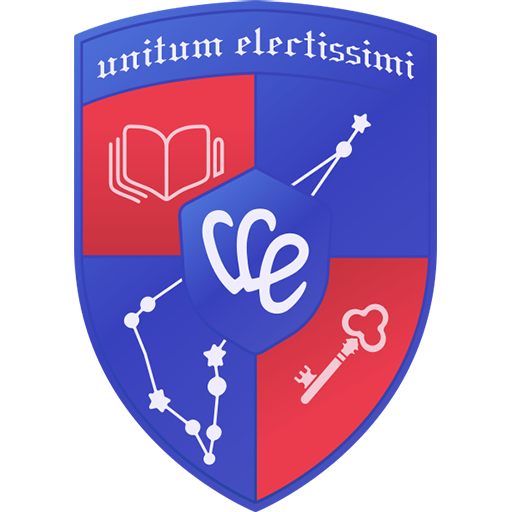2025 TMUA Post-Exam Analysis: A Quantitative Validation of Our High-Fidelity Mock Exams

Independent Teacher
2025 TMUA Post-Exam Analysis: A Quantitative Validation of Our High-Fidelity Mock Exams
The 2025 TMUA is all done and dusted. While all the talk was about ‘multiple papers’ and candidates were getting anxious about whether the difficulty was even fair, we were chuffed to find that the feedback from UEIE students was just… calm and confident.
And that calm wasn’t a fluke. It was the inevitable result we’d already predicted and proven. The bottom line is: even though the papers were all different, their core difficulty was precisely locked into a very specific range.
That is all down to the smart design of our prep system. In this article, I’m going to properly deconstruct that system and reveal the logic behind how our students stay so composed.
I. A Prep System Designed to Work: How to Handle the Real TMUA Challenge
The reason the UEIE prep system is so effective is that it’s not just theory. It’s a smart system, properly designed from the ground up to handle the messy, complex challenges of the real exam. The whole thing is built around our eight mock papers, which are split into three difficulty modes: ‘Simulation’, ‘Challenge’, and ‘Confidence’. Right, I’m going to break down the logic behind this, using what we saw in this year’s real TMUA exams.
1. The 'Simulation' Mode: Replicating the Battlefield to Beat the Clock
As always, the TMUA demands you be incredibly slick with your calculations, and the time pressure is relentless, from start to finish. The entire point of the ‘Simulation Mode‘ is to train students to make quick, accurate calculations and decisions under that exact pressure. By running these high-intensity mocks under strict exam conditions, our students just get used to the pace. That exam-hall ‘stress’ becomes their everyday ‘normal’. It means that when the time comes, they can comfortably bank all the marks from the standard questions without running out of time.
2. The 'Challenge' Mode: Pushing Your Limits to Tackle Those Weird, New Questions
Just like in previous years, there are always a few curveball questions designed to sort the top students from the rest. That’s exactly what our ‘Challenge Mode‘ is for. The goal is to smash through a student’s ‘thinking ceiling’. By training them with much harder, higher-level thinking, we give them the mental flexibility they need. When a student who’s been through the ‘Challenge Mode’ wringer sees a weird-looking question , they’re just much faster at seeing the underlying maths and finding a way in.
3. The 'Confidence' Mode: Building a Rock-Solid Foundation to Beat the 'Trap Questions'
One of the main things about this year’s exam was the sheer number of ‘trap’ questions. We’re talking nasty little traps hidden in the most basic definitions, logic, or boundary conditions—dead easy to fall for and hard to spot. This is exactly why our ‘Confidence Mode‘ is so essential. The aim here is to do a ‘carpet-bomb’ review of every single core topic, making sure those fundamentals are absolutely rock-solid. That way, our students can spot and dodge these simple-looking traps on autopilot, protecting all their hard-earned basic marks.
II. From Theory to Practice: How the Data Proves Our 'Two-Round, Three-Mode' System Works
Whether a prep system is actually any good all comes down to the data. Our system—what we call ‘Two Rounds, Three Modes, Four Stages, Eight Mocks’ – is built around this idea. It’s two rounds of the three difficulty modes, run in an alternating four-stage pattern of ‘Simulation-Challenge-Simulation-Confidence. We’ve got the hard, quantitative proof from our back-end data that this cyclical training flat-out works.
1. The 'Macro' Evolution: The Rhythm Behind the 'Growth Ladder'
Our TMUA Score Distribution Graph (see below) perfectly captures how the whole group of student ‘evolved’ through these repeating ‘stress-and-recover’ cycles. Let’s break down the rhythm behind these curves.
Round 1: 'Pressure and Recovery' (Mocks 1-4)
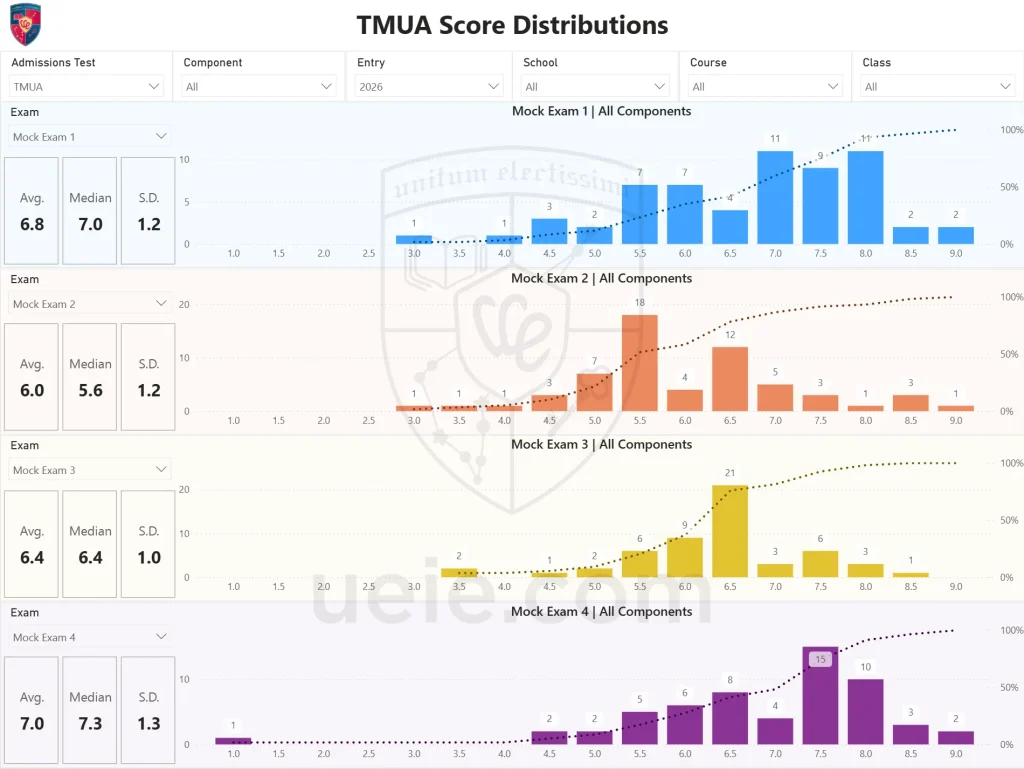
(Exam Period: Sept-Oct 2025)
First, the students set their baseline in Mock 1 (‘Simulation’). Then, we immediately hit them with a high-intensity stress test in Mock 2 (‘Challenge’), and you can see the scores clearly shift to the left (the average dropped from 6.8 to 6.0). This ‘planned dip’ was designed to expose all their weak spots. After that, Mock 3 (‘Simulation’) let them apply what they’d learned in a realistic test, and Mock 4 (‘Confidence’) pulled the difficulty back a bit. This let them consolidate their knowledge, rebuild their confidence, and you see the scores shoot right back up (average climbing to 7.0).
Round 2: 'Forging and Peaking' (Mocks 5-8)
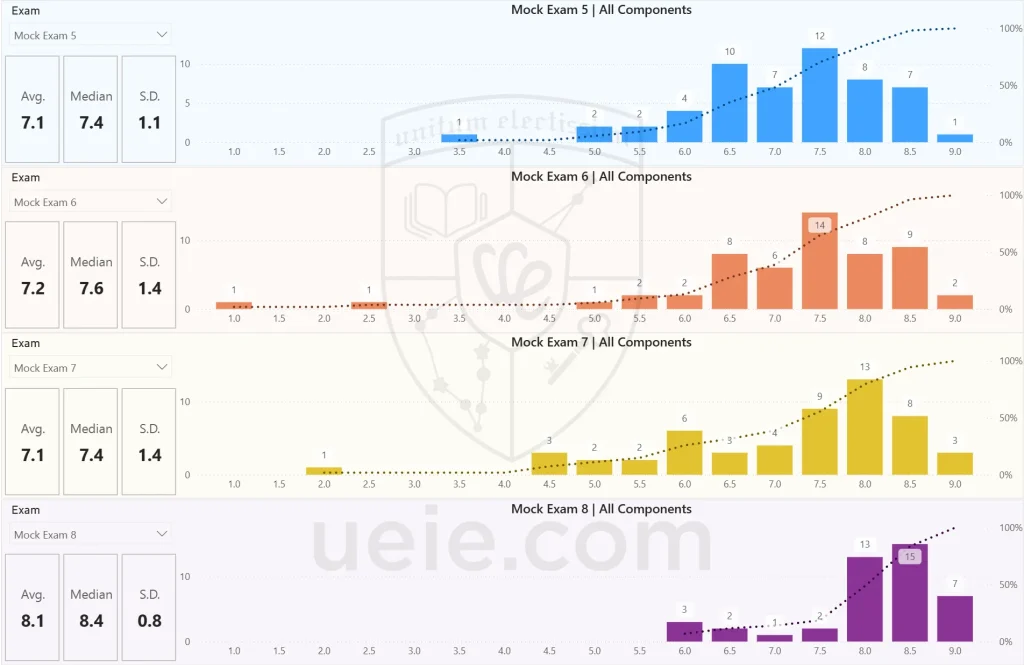
(Exam Period: Oct 2025)
Then, we simply repeated the cycle. But look closely: in Mock 6 (the second ‘Challenge’ test), the group’s scores didn’t nosedive this time. This is the single best bit of proof that the training was working: their knowledge base and their ability to handle pressure had been systematically toughened up, so they could take on the hard stuff without buckling. Finally, by Mock 8 (‘Confidence’), the entire group surged to a peak average of 8.1 and a median of 8.4, and they were all tightly clustered together with a standard deviation of just 0.8.
2. The 'Micro' Journeys: Two Classic Paths to the Top
Of course, this clever training rhythm needs to be paired with spot-on diagnostics. Our Student Personal Report system plots a totally unique growth curve for every single student. Here are the two most typical success stories.
The Textbook Case of 'Excellence and Stability'
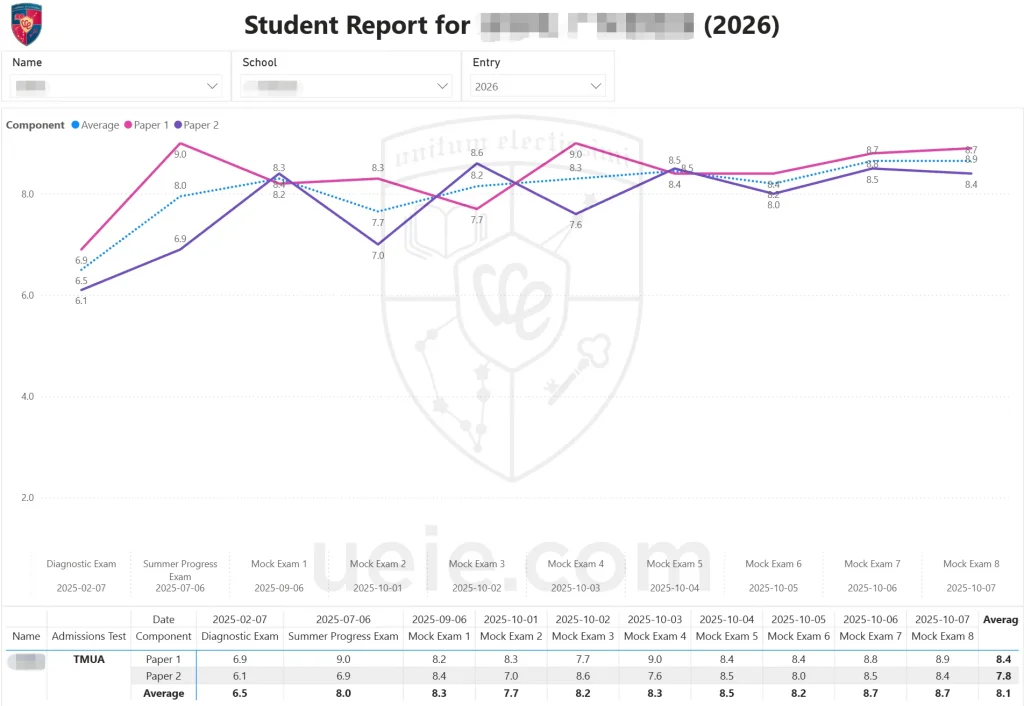
(Studying from Feb-Oct 2025)
Look at this student’s curve. It barely flinched, even during the two ‘Challenge’ mocks (2 and 6). It just shows how incredibly resilient they are. This proves our system helps top-tier students stay on top, handle the pressure, and turn excellence into a stable, repeatable habit.
The Definition of 'Resilience and Breakthrough'
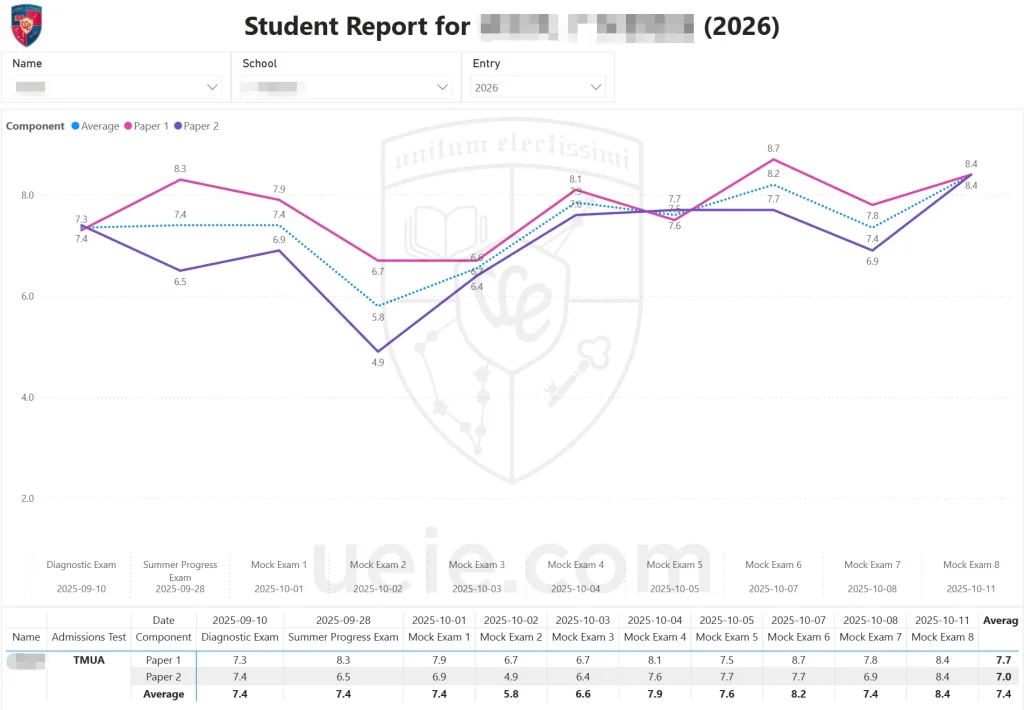
(Studying from Sept-Oct 2025)
This student did a full sprint-prep in less than two months, and their graph is the perfect ‘pressure-and-recovery’ story. This is what efficient prep and a personal breakthrough look like. They took a massive hit in Mock 2, but that became the catalyst. They used it to push on, climbed steadily through the rest of the mocks, and hit a new personal best in Mock 8. It’s just undeniable proof that our system can effectively guide students to learn from their ‘failures’ and come out stronger on the other side.
III. What's Next: Turning Your TMUA Edge into an Interview Win
Look, a top-notch TMUA score is a massive piece of academic proof when you’re applying for courses like Computer Science, Maths, or Economics at places like Cambridge, Imperial, and Warwick. But let’s be honest: all it does is get your foot in the first door.
The real decider is the interview. And it’s testing a completely different set of skills from the written exam. This is where you go from ‘theory on paper’ to a ‘face-to-face showdown’. The interviewers aren’t just looking for a student who can churn out the right answer anymore. They want to see a future academic—someone who can clearly explain how they’re thinking, even when they’re under pressure, and who shows genuine academic curiosity and a logical mind.
So, we’ve taken the exact same hardcore, systematic approach we used to deconstruct the TMUA exam, and we’ve applied it to deconstructing the interview. That’s why the UEIE Oxbridge Interview Coaching programme is now officially live. Our goal is dead simple: to take all the knowledge and confidence you built up for the exam and turn it into a decisive, winning performance in that interview room. We’re here to get you over that ‘final mile’.
Our entire course is built around three core modules:
1. 1-to-1 High-Fidelity Mock Interviews
These are led by tutors with serious, senior-level interview experience from Oxbridge and Imperial. We perfectly replicate the pressure and academic depth of the real thing, giving you proper, hands-on combat practice.
2. Logical Framework & Verbal Expression Training
We don’t feed you ‘standard answers’. We train you how to build and communicate your thought process, clearly, even when you’re under the cosh. This is the toolkit that will let you handle any curveball question they throw at you with total confidence.
3. Pushing Your Horizons to the Academic Frontier
We’ll get you discussing cutting-edge topics that go way beyond the A-Level syllabus. This is all about helping you build your own unique academic perspective, so you can walk in there and show them you’ve got real passion and huge potential for the subject.
Act Now
To make sure the coaching quality is absolutely top-tier, our interview places are strictly limited, and they are only available to students who have already bought UEIE courses or study materials. If history is anything to go by, these spots will be snapped up incredibly fast.
Follow Us on Wechat

